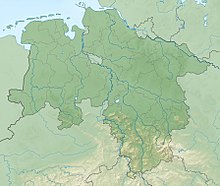Palatinate Grona
Coordinates: 51 ° 33 ′ 7.1 ″ N , 9 ° 54 ′ 46.4 ″ E
The Palatinate Grona (partly also Palatinate Grone ) was a royal palace in the area of today's city of Göttingen and one of the roots of today's district of Grone . It was first mentioned in 915 as Grona Castle and completely demolished in 1387 by the Göttingen citizens.
location
The Palatinate Grona was northwest of Göttingen on the upper edge of the steep bank to the Leinetal on the Hagenberg. The river Grone runs directly below the slope . The area was located to the east and north of today's Friedenskirche and is now wooded. Archaeological traces were also found during the construction of the church and community center. Today the area belongs to the Weststadt .
history
The Palatinate is one of the five palace complexes in today's Lower Saxony ( Werla , Goslar , Dahlum , Pöhlde ).
The "urbs, quae Grona dicitur" was located near the present-day district of Grone; in 915 Heinrich , Duke of Saxony (born approx. 876), from the house of the Liudolfingers , was besieged by the East Franconian King Konrad I (911–918). Konrad broke off the siege prematurely because - according to legendary tradition - a friend of Heinrich's, Thietmar, pretended to the Frankish negotiators that his relief troops were about to arrive. Discouraged by his failures, Konrad later designated his opponent for the king's election. Heinrich I (919–935) was elected king; he was the first Saxon among the German kings. He did not accept the imperial title .
With him, the Liudolfingian castle was raised to the status of the royal Palatinate of Grona and, especially under Henry II , experienced brilliant days. In 1012 the investiture and ordination of Waltard as Archbishop of Magdeburg took place here , in 1022 that of Godehard as Bishop of Hildesheim ; in other years imperial assemblies met here. With a total of 18 attested royal and imperial stays between 941 and 1025, the Palatinate Grona is a specifically Ottonian Palatinate of high rank. Heinrich I provided his widow with this property, among other things. Stays of Otto I. , Otto II. And Otto III are also proven . Finally, for Heinrich II and his wife Kunigunde , Grone was a popular place to stay. Heinrich II, seriously ill, moved here in the summer of 1024, where he died on July 13 of the same year. With him the heyday of the Palatinate came to an end.
The Palatinate lost its importance under the Salians. In the Sachsenspiegel , however, it is still mentioned (first) among the five Falzes in Saxony.
The Palatinate, which was destroyed in the battles between Heinrich the Lion and the imperial power, was rebuilt as a castle at the beginning of the 13th century by the von Grone family of ministers , but destroyed in 1294 by the citizens of Göttingen. The Palatinate area and the lands belonging to the Palatinate came to the city of Göttingen via the lords of Adelebsen and von Hardenberg in 1371/72. The place Grone, however, remained independent.
At the beginning of the 14th century, the palace buildings were destroyed by the Göttingen citizens and used as a quarry in the following years.
present
Today only the outer wall appearing as a wall and a memorial stone from the former Palatinate, to which a royal court, a fortified Franconian estate on an advance road, belonged in the nearby village of Grone. This is remembered with the street names "Königsstieg", "Königshof" and "Königsallee".
A memorial stone can now be found at the publicly accessible location. There are information boards in the tower of the Friedenskirche. The exact location of the Palatinate is not indicated on site.
The Catholic parish church of Grone (1972) bears the name of Saints Heinrich and Kunigunde.
literature
- Günther Binding : German royal palaces. From Charlemagne to Frederick II (765–1240). Primus, Darmstadt 1996, ISBN 3-89678-016-6 .
- Otto Fahlbusch : Topography of the City of Göttingen (= studies and preliminary work for the Historical Atlas of Lower Saxony. 21, ISSN 0933-2960 ). Vandenhoeck & Ruprecht, Göttingen 1952.
- Adolf Gauert: The excavations on the site of the Palatinate Grone. In: German royal palaces. Contributions to their historical and archaeological research (= publications of the Max Planck Institute for History. 11, 2, ISSN 0436-1180 ). Volume 2. Vandenhoeck & Ruprecht, Göttingen 1965, pp. 114–125.
- Erich Heinze: The development of the Pfalzgrafschaft Saxony up to the 14th century. In: Saxony and Anhalt. Vol. 1, 1925, ISSN 0945-2842 , pp. 20-63 .
- Rudolf Pörtner : The Roman Empire of the Germans. Cities and sites of the German Middle Ages (= Knaur Taschenbuch. 227, ISSN 0452-1064 ). Knaur, Munich 1970.
- Alexander Thon : Barbarossaburg, Kaiserpfalz, Königspfalz or Casimirschloß? Studies on the relevance and validity of the term "Pfalz" in the High Middle Ages using the example of (Kaisers-) Lautern. In: Kaiserslauter Yearbook for Palatinate History and Folklore. 1, 2001, ISSN 1619-7283 , pp. 109-144.
Web links
- Entry by Stefan Eismann on Pfalz Grona in the scientific database " EBIDAT " of the European Castle Institute



